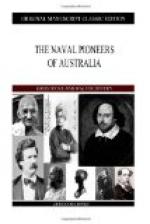The small arms were matchlocks, snaphainces, musketoons, blunderbusses, pistols, halberts, swords, and hangers.
From this it will be seen that the Roebuck’s guns, considering the peaceful service she was upon, were probably known to her company as “sakers” and “falcons.”
In a sixth-rate the sakers were carried all on the one deck, and the minions on the quarterdeck. Charnock supplies an illustration of a sixth-rate of the time, and the picture is a familiar one to all who have taken even a slight interest in the ships of a couple of centuries ago. A lion rampant decorates the stem, set as it remained till early in the present century (the galley prow had gone with Charles I.); the hull looked not a whit more clumsy than that of an old north-country collier of our youth, but the flat stern, with its rows of square windows, richly carved panelling, and big stern-lanterns, and the row of round gun-ports encircled by gold wreaths along the ship’s sides, are distinctive marks of this period.
A vessel of this kind was ship-rigged, about 88 feet long by 24 feet beam; the depth of her hold, in which to store her twenty months’ provisions (a marvellously large quantity as stores were then carried), was about 11 feet, and her draught of water when loaded about 12 feet aft. She had one deck and a poop and forecastle, the former extending from either end of the ship to the waist. A good deal of superfluous ornament had by this time been done away with, although there was plenty of it so late as 1689. Charnock describes a man-of-war of that date. After the Restoration, ships grew apace in grandeur in and out. Inboard they were painted a dull red (this was, it is said, so that in fighting the blood of the wounded should not show), outside blue and gilded in the upper parts, then yellow, and last black to the water-line, with white bottoms. Copper sheathing had not come into use, and ships’ bottoms were treated with tallow, which was made to adhere by being laid on between nails which studded the bottom.
The pitching of the vessels imperilled the masts of these somewhat cranky ships of 1689, says a writer of about Dampier’s time, who also tells us that ships then had awnings, and that “glass lanthorns were worthier best made of crystal horn; lanthorns were worthier than isinglass.”
The sails were the usual courses: big topsails and topgallantsails, staysails, and topmastsails, with a spritsail and a lateen-mizen; the spanker and jib were not yet, but the sprit-topsail had just gone out. The ship when rigged and fitted ready for sea probably cost King William’s Admiralty about L10,000. But the Roebuck was pretty well worn out when Dampier was given the command of her, as he tells us when relating her subsequent loss.




